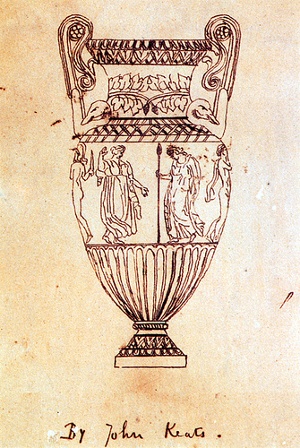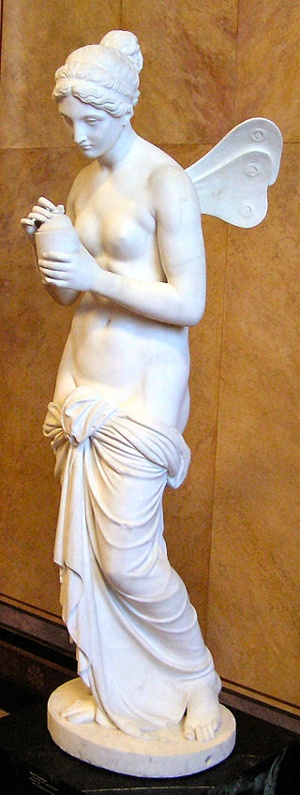John Keats, selected poems Contents
Beauty
Beauty as diversion
For Keats, the contemplation of beauty was a way of delaying the inevitability of death. Although we must die eventually, we can choose to enrich our lives by being surrounded by beautiful objects and landscapes. Keats’ speakers contemplate urns (Ode on a Grecian Urn), books (On First Looking into Chapman’s Homer, On Sitting Down to Read King Lear Once Again), birds (Ode to a Nightingale), and stars (Bright star, would I were steadfast as thou art). Unlike mortal beings, beautiful things will never die but have a sort of immortality, demonstrating their beauty for as long as there are humans to appreciate it.
The letters
Keats states, in a letter to Richard Woodhouse, that 'the mere yearning and fondness’ he has for the beautiful is the greatest impetus for his poetry.
Keats expressed many of his ideas about poetry and aesthetics in general in his letters and amongst his statements about beauty are the following:
- ‘I have the same Idea of all our Passions as of Love: they are all, in their sublime, creative of essential Beauty.’
(Letter to Benjamin Bailey, 22.11.1817)
- ‘the excellence of every Art is its intensity, capable of making all disagreeables evaporate, from their being in close relationship with Beauty and Truth.’
(Letter to George and Tom Keats, 22.12.1818)
- ‘I think poetry should surprise by a fine excess and not by Singularity.’
(Letter to John Taylor, 27.02.1818)
- ‘with a great poet the sense of Beauty overcomes every other consideration, or rather obliterates all consideration.’
(Letter to George and Tom Keats, 22.12.1818)
But the nature of beauty itself is something Keats also explores in his poems.
The Odes
 In Ode on Melancholy, Keats expresses the Romantic idea that beauty and joy can only be found in opposition: beauty can only be found in melancholy. Ode on a Grecian Urn, however, concludes with the timeless lines, ‘Beauty is Truth, Truth Beauty,’ perhaps a simpler concept and a more reassuring answer. In any case, a love of beautiful things - both physical and philosophical - is one of the touchstones of Keats' work.
In Ode on Melancholy, Keats expresses the Romantic idea that beauty and joy can only be found in opposition: beauty can only be found in melancholy. Ode on a Grecian Urn, however, concludes with the timeless lines, ‘Beauty is Truth, Truth Beauty,’ perhaps a simpler concept and a more reassuring answer. In any case, a love of beautiful things - both physical and philosophical - is one of the touchstones of Keats' work.
The speaker in Ode on a Grecian Urn envies the immortality of the lute players and trees inscribed on the ancient vessel because they shall never cease playing their songs, nor will they ever shed their leaves. He reassures young lovers by telling them that, even though they shall never catch the objects of their desire, these women shall always stay beautiful. The people on the urn, unlike the speaker, shall never stop having these experiences. They shall remain permanently depicted, whilst the speaker changes, grows old and eventually dies.
Beauty and intensity
Keats found beauty in intensity: the ‘fine excess’ of his imaginary worlds whose hallmark is a richness of imagined sensations. A memorable example of this intensity can be found in the Ode to a Nightingale in which Keats does not merely ask for a glass of wine as relief from his confused emotions. Rather he cries out:
Cool’d a long age in the deep-delv’d earth,
Tasting of Flora and the country green,
Dance, and Provencal song, and sunburnt mirth!
O for a beaker of the warm South…
The beauty of the glass of wine comes from its intensity, its capacity for multi-sensory experience and for a rich diversity of associations. It combines sight, taste, touch. The wine is not only a drink but also a means of capturing memories of dance, song and having fun under a hot sun. ‘Deep-delved’ (with its vividly suggestive alliteration) reminds the reader not only of cellars in which the wine is stored but also the strenuous efforts made by human hands to create them.
 Female figures
Female figures
Beautiful, mystical female figures are a constant presence in Keats' poetry: these range from Psyche in Ode to Psyche, to the Belle Dame in La Belle Dame Sans Merci, to the female figures of Love, Ambition, and Poesy in Ode on Indolence. Female figures are often marked by a dreamy otherworldliness; in fact, even mortal women like the mistress in Ode on Melancholy have ‘peerless eyes’ that are to be ‘fed upon’ in the midst of angry moods.
Beauty and pain
As so often in Keats, the contemplation of beauty leads to a painful awareness that perfection cannot last. The human imagination allows us to transcend the mind’s transitory sensations. The artist can create beauty and is able to awaken in his audience a desire to experience beauty as something eternal. However, this is just an illusion: human life is subject to time and change. Keats knows that art has its limitations. If it redeems experience at all it, is not because it is eternal and unchanging but rather because it offers beauty of a more rational kind: that is, it offers us a more profound comprehension of ourselves rather than allowing us to escape from the constraints of daily life.
Recently Viewed
-
John Keats, selected poems » Beauty
now -
John Keats, selected poems » To Sleep: Language, tone and structure
just now -
John Keats, selected poems » Ode to Autumn: Language, tone and structure
just now -
John Keats, selected poems » O Solitude, if I must with thee dwell: Language, tone and structure
1 minute ago -
John Keats, selected poems » Keats' beliefs
2 minutes ago -
John Keats, selected poems » Timeline
3 minutes ago -
A-Z: General definitions » Eternal Life
3 minutes ago -
John Keats, selected poems » Ode to a Nightingale: Synopsis and Commentary
4 minutes ago -
John Keats, selected poems » La Belle Dame Sans Merci: Synopsis and commentary
4 minutes ago -
John Keats, selected poems » The medical profession
5 minutes ago -
John Keats, selected poems » The context of John Keats' poetry
5 minutes ago -
John Keats, selected poems » On the Sea: Language, tone and structure
6 minutes ago -
John Keats, selected poems » Ode on a Grecian Urn: Language, tone and structure
7 minutes ago -
John Keats, selected poems » Hush, hush! tread softly! - Language, tone and structure
7 minutes ago -
A-Z: General definitions » Jesus
7 minutes ago -
John Keats, selected poems » To Ailsa Rock: Synopsis and Commentary
7 minutes ago -
John Keats, selected poems » Sleep and Poetry: Synopsis and Commentary
11 minutes ago -
John Keats, selected poems » How to plan an essay
11 minutes ago
Scan and go

Scan on your mobile for direct link.